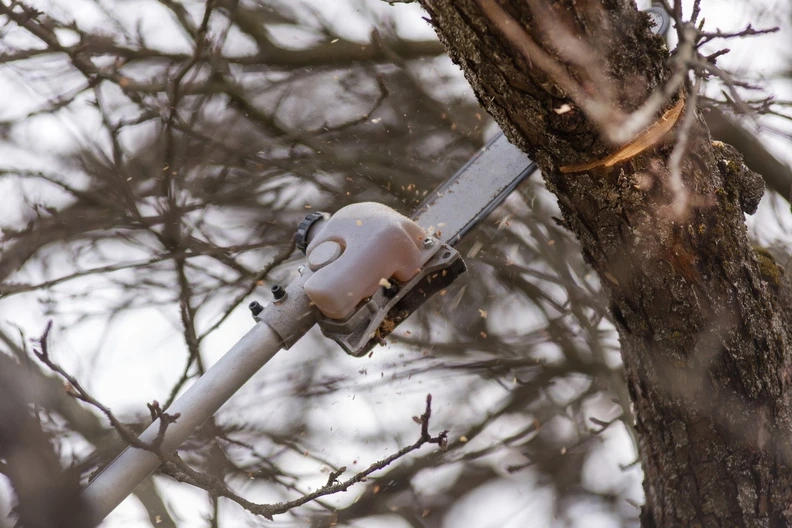Stump grinding is a method of removing the visible remains of a tree stump using a specialized machine called a stump grinder. This process involves grinding the stump down to several inches below ground level, effectively eliminating it as a visual and physical obstacle in the landscape. Stump grinding is necessary for several reasons:
Aesthetics: Tree stumps can be unsightly and detract from the overall appearance of a yard or garden. Removing them can enhance the visual appeal of the landscape.Safety: Stumps can pose tripping hazards, especially for children and the elderly. They can also obstruct lawn maintenance equipment, potentially causing accidents or damage.Pest Control: Stumps can attract pests such as termites, ants, and beetles, which can then spread to healthy trees or even homes.Space Utilization: Removing stumps frees up space for new plantings, lawn expansion, or other landscaping projects.Disease Prevention: Stumps left behind from diseased trees can harbor pathogens that might spread to other plants in the area.Stump Grinding vs. Stump Removal
Stump grinding and stump removal are two different approaches to dealing with tree stumps. Stump grinding focuses on using a machine to shred the stump into wood chips, leaving the roots intact underground. This method is less invasive and more cost-effective than full stump removal. On the other hand, stump removal involves extracting the entire stump along with its root system from the ground, which can be labor-intensive and may require heavy machinery, leaving a large hole that needs to be filled in afterward.
Stump Grinding Techniques and Equipment
Overview of Different Stump Grinding Machines and Their Uses
Stump grinding machines, commonly known as stump grinders, come in various sizes and configurations, each suited for different types of jobs. The main types of stump grinders include:
Handheld Stump Grinders: These are portable and typically used for small stumps or in tight spaces. They are less powerful but convenient for minor tasks.Walk-Behind Stump Grinders: These machines are larger than handheld versions and offer more power and depth control. They are suitable for medium-sized stumps and are still relatively easy to maneuver.Tow-Behind Stump Grinders: These grinders are designed to be towed behind a vehicle and are ideal for larger stumps or multiple stumps. They offer substantial power and efficiency for more extensive projects.Self-Propelled Stump Grinders: These are high-powered, versatile machines that can handle large stumps and rough terrain. They are commonly used by professional landscapers and tree service companies.Each type of stump grinder has its advantages and is selected based on the size of the stump, the terrain, and the specific requirements of the job.
Safety Precautions and Best Practices When Operating Stump Grinders
Operating stump grinders requires careful attention to safety to prevent accidents and injuries. Key safety precautions and best practices include:
Wear Protective Gear: Always wear appropriate personal protective equipment (PPE), such as safety glasses, ear protection, gloves, and sturdy boots.Inspect the Area: Before starting the grinding process, inspect the area for obstacles, such as rocks, debris, or underground utilities, that could interfere with the operation.Check the Equipment: Ensure that the stump grinder is in good working condition, with all safety guards and mechanisms intact and functional.Clear the Area: Keep bystanders, pets, and other workers at a safe distance from the work zone to avoid accidents.Follow Manufacturer’s Instructions: Adhere to the operating guidelines provided by the manufacturer, including proper startup and shutdown procedures.Maintain Stability: Position the grinder on stable ground and use the machine's controls to maintain balance and control during operation.Gradual Grinding: Use a gradual, controlled motion to grind the stump, avoiding aggressive or jerky movements that could cause the machine to kick back or lose stability.Preparing for Stump Grinding
How to Prepare Your Yard for Stump Grinding
Proper preparation is essential to ensure a smooth and efficient stump grinding process. Steps to prepare your yard include:
Identify Utilities: Locate and mark any underground utilities, such as gas, water, and electrical lines, to prevent accidental damage during grinding.Clear the Area: Remove any rocks, debris, or other obstacles from around the stump that could interfere with the grinder.Trim Surrounding Vegetation: Cut back any grass, plants, or bushes around the stump to provide clear access for the grinder.Mark Boundaries: Use flags or markers to delineate the work area and ensure that the grinder operator is aware of the stump's exact location.Inform Neighbors: If the stump is near a property line, inform your neighbors about the upcoming work to avoid any misunderstandings.What to Expect During the Stump Grinding Process
Understanding what to expect during the stump grinding process can help you prepare and minimize any disruptions:
Noise and Dust: Stump grinding can be noisy and produce a significant amount of dust and wood chips. Wearing ear and eye protection is advisable, and keeping windows closed if the grinding is near a building can help minimize dust intrusion.Duration: The time required for stump grinding depends on the size and type of stump, as well as the equipment used. Small stumps might take only an hour, while larger stumps could require several hours.Cleanup: After grinding, a pile of wood chips will remain. These can be used as mulch or removed from the site. The ground area will be relatively level but might need additional soil and seeding if you plan to replant grass or other vegetation.Residual Roots: While stump grinding removes the visible portion of the stump, some roots may remain underground. These typically decompose over time but might require additional attention if they interfere with new plantings or structures.By understanding the basics, techniques, and preparation involved in stump grinding, homeowners and landscapers can effectively manage tree stumps and maintain a safe, attractive, and functional landscape.


